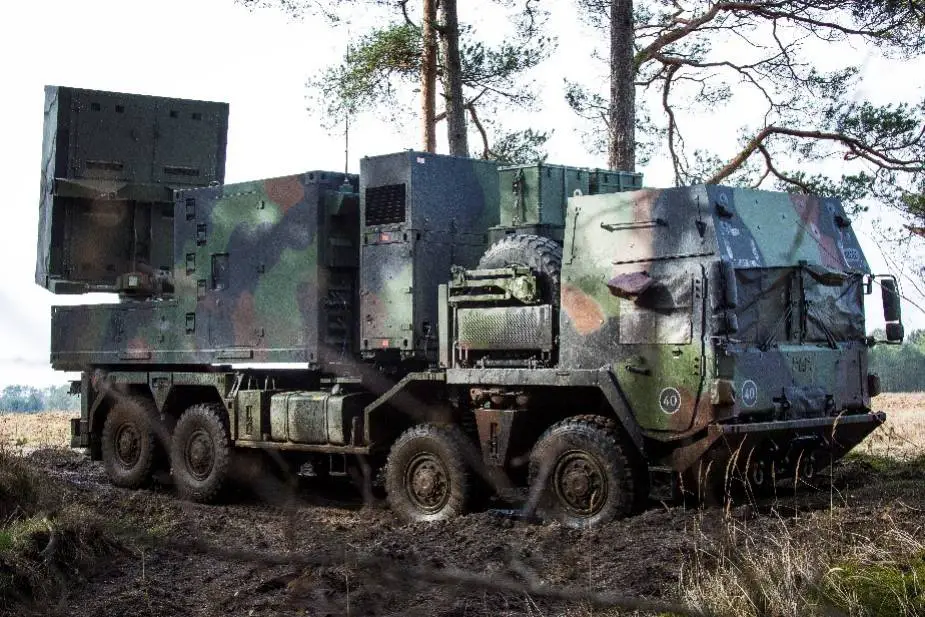Breaking news
Germany clears sale of 155m Vulcano precision-guided artillery shells, COBRA radars and IRIS-T missiles to Ukraine.
According to Anwesha Majumdar in RepublicWorld.com, the Chancellor of Germany, Olaf Scholz, on Sunday, August 21, announced the shipment of COBRA counter-battery radar and IRIS-T missiles to Ukraine.
Follow Army Recognition on Google News at this link

VULCANO is a family of unguided (BER) and guided (GLR) ammunition for the 76mm, 127mm naval guns and 155mm land artillery systems. (Picture source: Leonardo)
German newspaper Die Welt's website on May 4, 2022, already announced that Germany planned to supply Cobra counter-artillery radars to Ukraine. This announcement came after the announcement of Germany to provide PzH 2000 155mm self-propelled howitzers to Ukraine.
Germany has now authorized the sale of 255 high-precision 155mm Vulcan-guided artillery shells to Ukraine. According to the German publication Welt am Sonntag, no precise delivery date has been set yet. Defense companies of Germany (Diehl Defence) and Italy (Leonardo) have jointly produced Vulcano shells.
In addition to this, the Chancellor of Germany, Olaf Scholz on Sunday announced the shipment of the COBRA counterbattery radar and the IRIS-T air defence system to Ukraine. Referring to the weapons, Scholz said that they "will soon be" in Kyiv. According to Nexta, he also said that Germany will keep giving Ukraine "what it needs for defense."
Vulcano 155mm artillery shells
Vulcano 155mm is a family of subcalibre ammunition for 155mm Land artillery systems composed by an unguided projectile called BER (Ballistic Extended Range) and a guided one called GLR (Guided Long Range). They represent the most advanced technology currently available for precise land artillery firings.
The Vulcano projectile is specifically conceived and realized to improve the performance of other
ammunition of the same calibre, both in range and accuracy while maintaining compatibility with the in-service propelling charges and 155mm barrels. The outline of the ammunition is almost identical to that of conventional rounds, which enables it to be handled without any additional logistical burden.
The main application of the Vulcano 155 GLR is for long-range, high-accuracy fire support against stationary and moving point targets with an extremely reduced likelihood of collateral damage.
The outstanding aerodynamics, coupled with the GPS guidance and trajectory shaping capabilities, enable the Vulcano 155 GLR to reach a max range of 70km while keeping an extreme accuracy of fewer than 5m within all operational ranges.
The shell is filled with IM explosive and it is made up of specific patented pre-formed tungsten rings, enabling extremely high effectiveness against soft and lightly protected targets; the detonation trigger is generated by a Radio Frequency programmable fuse capable of various functionalities, such as altimetric, instantaneous and delayed impact. When the RF fuse is replaced with the dedicated Semi-Active Laser (SAL) sensor, the ammunition can also effectively engage laser-designated targets (forward observer required), stationary and moving, with further improved precision with respect to pure GPS guidance.
Moreover, the possibility of programming the final attack angle of the projectile to up to 90° (that is, vertical fall) against the target enables the maximization of both warhead effectiveness and guidance accuracy, as well as minimizing the likelihood of detection of the projectile in flight by the enemy’s defence systems.
The Vulcano 155 ammunition, both BER and GLR, have been qualified according to the relevant STANAGs under joint Italian and German MoD supervision.

The COBRA is a COunter Battery RAdar mounted on a truck chassis. (Picture source: OCCAR)
COBRA
The COBRA, which stands for COunter Battery RAdar, was jointly developed by Thales, Airbus Defence and Space and Lockheed Martin for the German, French and British armed forces. The radar entered into service in 2005.
The COBRA is considered the world's most advanced land-based weapon locating system, comprising a high-performance radar, advanced processing, and integrated, flexible command, control, and communication system. The design includes state-of-the-art digital processing and advanced active, solid-state phased array antenna comprising several thousand transmit/receive modules.
The COBRA mission is to locate mortars, rocket launchers and artillery batteries and to provide information for countering their effectiveness. With a detection range up to 100 km, COBRA is capable of locating and classifying up to 40 batteries in two minutes. It will also be able to monitor breaches of cease-fire when deployed in a peace-keeping role.

IRIS-T displayed at the ILA expo in Berlin in 2006 in front of a Eurofighter (Picture source: Wikipedia)
IRIS-T
The IRIS-T ("InfraRed Imaging System Tail/Thrust Vector-Controlled") is a German-led program to develop a short to medium-range infrared homing air-to-air missile to replace the AIM-9 Sidewinder found in some NATO member countries. Any aircraft capable of firing the Sidewinder is also capable of launching the IRIS-T.


























